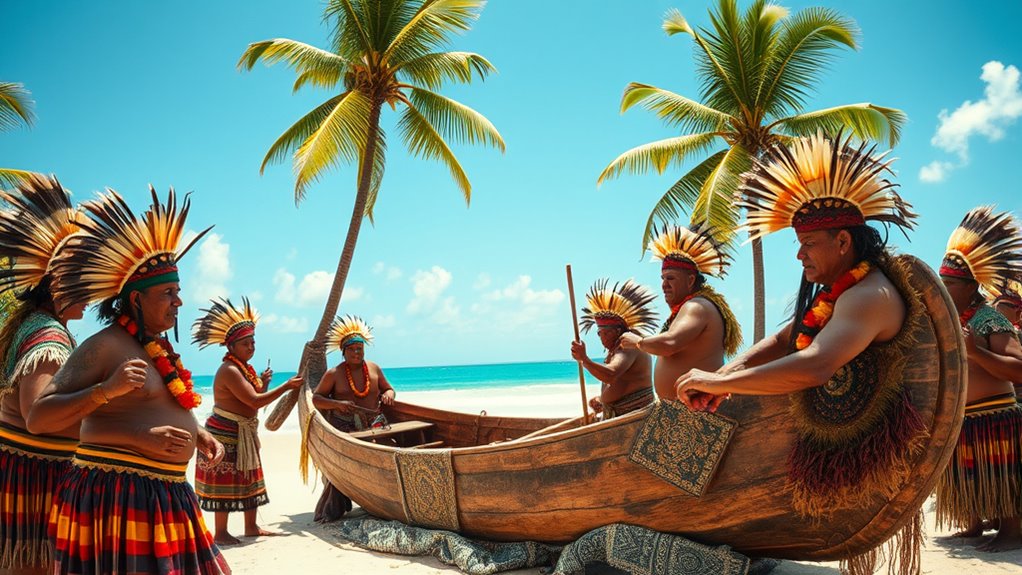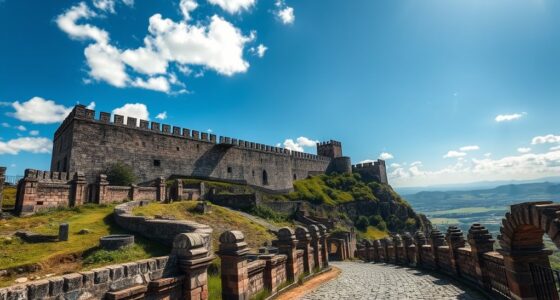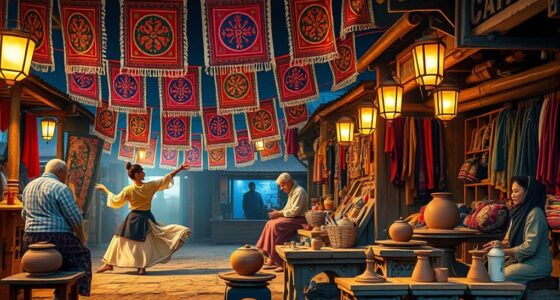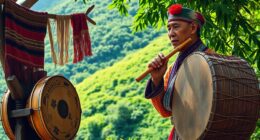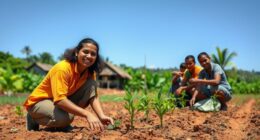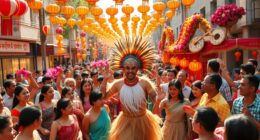Immerse yourself in Pacific island traditions by experiencing their vibrant food customs, where local ingredients and cooking techniques like earth oven roasting enrich communal meals. Learn how oral stories and language keep history alive across generations. Feel the strong social bonds through shared rituals and community efforts. Explore traditional crafts that connect past and present, and celebrate colorful festivals filled with dance, music, and ceremonies. Keep exploring to uncover more about these enthralling cultural lifestyles.
Key Takeaways
- Traditional island cuisines utilize local ingredients and methods like earth oven roasting and leaf-wrapped dishes, emphasizing communal cooking.
- Oral traditions, including storytelling, song, and genealogies, preserve history, language, and cultural values across generations.
- Social bonds are reinforced through shared meals, kinship networks, respect for elders, and community rituals.
- Craftsmanship such as wood carving, tapa cloth making, and pottery expresses cultural identity and spiritual beliefs.
- Festivals and ceremonies featuring dance, music, and rituals celebrate heritage and strengthen regional unity.
Culinary Heritage and Food Practices

Have you ever wondered how island communities preserve their unique culinary identity? It all comes down to traditional cooking methods that rely heavily on island ingredients. Root vegetables like taro and yams form the staple carbohydrate base, while seafood such as fish and turtle provides essential protein. Tropical fruits like coconut, pineapple, and mango add flavor and variety, often featured in beverages and desserts. Coconut milk and cream enrich dishes like palusami and desserts, highlighting local flavors. Cooking techniques like earth oven roasting and steaming preserve natural tastes while imparting distinctive smoky flavors. Food preparation often involves wrapping ingredients in taro leaves or coconut shells, emphasizing communal effort and cultural significance. These practices keep their culinary heritage alive, celebrating the harmony between land, sea, and tradition. Traditional cooking techniques such as slow-cooking in banana leaves or using umu ovens are passed down through generations, ensuring the continuation of authentic flavors and methods. Additionally, the use of cultural practices like communal feasts and storytelling helps reinforce the importance of traditional foodways within the community.
The Power of Oral Traditions and Language
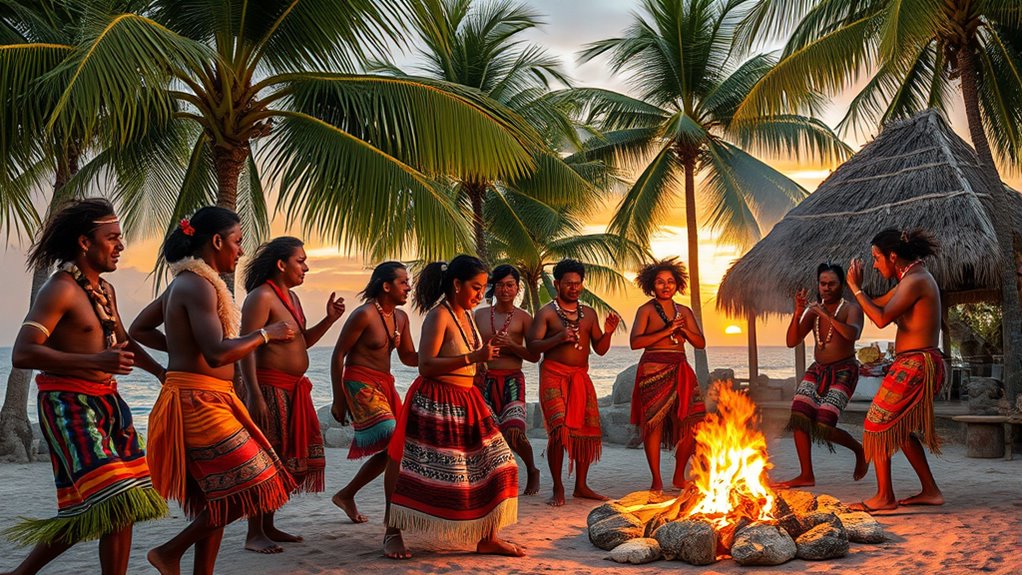
Island communities have long relied on oral traditions to pass down their history, customs, and values, forming the backbone of their cultural identity. Through storytelling techniques like song, dance, and ritual performances, they preserve living archives of their history and culture. These traditions emphasize the importance of language preservation, ensuring that native tongues stay vibrant and relevant. Oral histories, especially genealogies, serve as essential links to ancestors and land, often recited with ritual precision. Despite the rise of literacy, these traditions continue to play a fundamental role in education and social cohesion. Furthermore, incorporating local languages into formal education systems supports the continuity of these oral traditions. By actively maintaining oral practices, Pacific Islanders uphold their heritage, reinforcing community bonds and passing knowledge across generations in ways that written records alone cannot replicate.
Social Bonds and Community Values

What keeps Pacific Island communities tightly knit despite modern influences? It’s the strength of kinship networks and a deep sense of communal responsibilities. You’re part of a system where shared meals, multigenerational households, and community projects reinforce bonds and promote solidarity. Reciprocal sharing isn’t just generosity; it’s a moral duty that sustains extended family ties and helps communities thrive with limited resources. Respect for elders and intergenerational learning strengthen social cohesion, emphasizing collective accountability over individual achievement. Even as Western cash economies introduce change, these traditions remain crucial to your identity. You understand that caring for elders and supporting extended family networks create resilience and continuity. Traditional practices like storytelling and communal rituals help transmit cultural values and foster mutual understanding across generations. These practices are often supported by local social structures, which serve to organize and uphold community participation. Through daily routines, rituals, and mutual obligations, Pacific Islanders uphold social harmony and reinforce their cultural values.
Traditional Crafts and Material Culture

Traditional crafts and material culture are essential expressions of Pacific Island identities, showcasing skills passed down through generations. You’ll see ancient techniques in wood carving, where hardwoods like koa and sandalwood are shaped with chisels and adzes to create intricate objects. These carvings often depict ancestral figures, masks, and ceremonial tools, serving as powerful artistic symbols of spiritual beliefs and social status. Barkcloth and tapa cloth making involve pounding inner bark from trees such as mulberry, then decorating these flexible sheets with natural dyes and patterns that reflect clan identity. Regionally, sculptures like Malangan figures and carved paddles demonstrate regional diversity and craftsmanship. These craft objects and textiles are integral to rituals, storytelling, and social hierarchy, embodying the enduring cultural heritage of the Pacific Islands. Additionally, understanding the subconscious power behind these artistic expressions reveals how they serve as manifestations of collective cultural vibrancy and spiritual connection.
Celebrations and Cultural Festivals
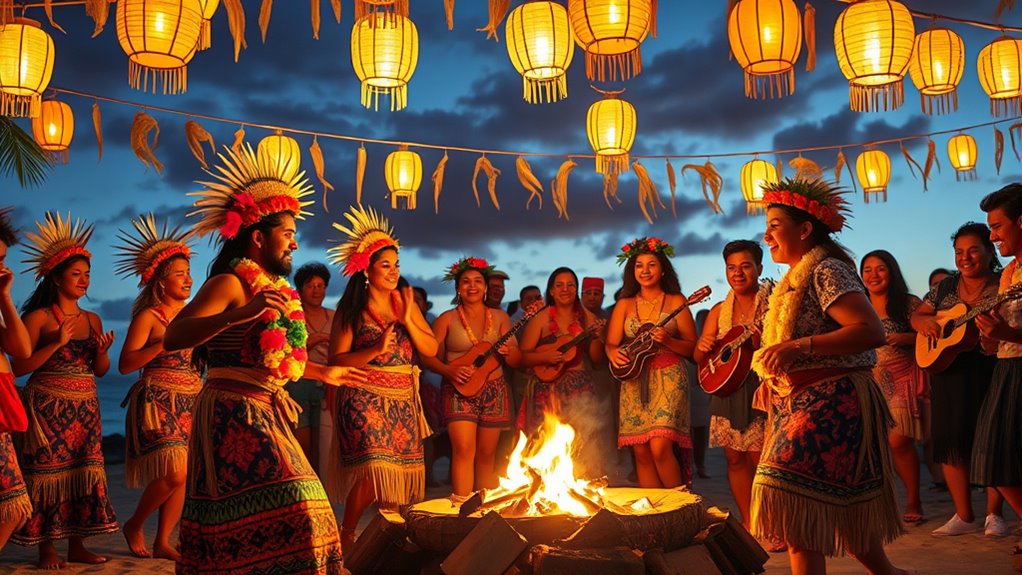
Have you ever wondered how Pacific communities celebrate their cultural heritage? During festivals, you’ll witness vibrant traditional dances like Fiji’s meke or New Zealand’s haka, bringing ancient rhythms and stories to life. Festival rituals, such as the Kava ceremony or warrior dances, deepen the spiritual and communal significance. These events also showcase performances from the Festival of Pacific Arts (FestPAC), uniting diverse cultures through music and dance. Incorporating traditional craft techniques, such as candle making or textile arts, further enriches these cultural expressions.
| Island Nation | Key Festival Rituals | Traditional Dance Highlight |
|---|---|---|
| Fiji | Meke dances, story-telling | Mele, tribal storytelling |
| New Zealand | Haka, powhiri | War dances, haka |
| Solomon Islands | Warrior dances, ancestral rites | Powerful war dances |
These celebrations preserve traditions, promote cultural identity, and foster regional unity.
Frequently Asked Questions
How Do Traditional Island Diets Adapt to Modern Food Availability?
You see that traditional food sourcing has changed due to modern dietary shifts, making it harder to access and prepare native foods. You might rely more on imported processed foods because they’re convenient and affordable, which challenges cultural food practices. To adapt, communities are promoting local ingredients through initiatives like the Pacific Island Food Revolution, encouraging a return to traditional diets and strengthening cultural pride amid changing food availability.
What Are the Challenges in Preserving Native Languages Today?
You face multiple challenges in preserving native languages today. Urbanization, globalization, and societal shifts weaken linguistic revitalization and cultural preservation. Funding cuts, policy gaps, and limited resources hinder education and community efforts. Technological barriers reduce access and learning opportunities, while declining fluent speakers and societal stigma diminish motivation. Without strong support, these obstacles threaten to erase indigenous languages, making it essential for you to advocate for policies that protect and promote cultural heritage through linguistic revitalization.
How Do Community Rituals Influence Individual Identity?
You see, community rituals play a essential role in shaping your values and strengthening community bonding. When you participate in traditional ceremonies, you connect deeply with your cultural roots and reinforce shared beliefs. These rituals serve as a powerful way to define your identity within the community, fostering pride and unity. By engaging in these practices, you help preserve your heritage while building lasting bonds that support your sense of belonging and cultural continuity.
In What Ways Are Traditional Crafts Evolving With Technology?
Imagine traditional crafts as a vibrant river, flowing through time. Now, digital weaving and 3D printing are like new tributaries merging into this stream, enriching it with innovation. You see, these technologies allow artisans to reimagine age-old techniques, blending heritage with modern tools. This evolution not only preserves crafts but also expands their reach, creating fresh expressions that honor tradition while embracing the future.
How Do Festivals Promote Intercultural Understanding Beyond the Islands?
You see how festivals promote intercultural understanding beyond the islands through cultural exchange and their festival significance. They bring together diverse communities, showcasing shared traditions and fostering dialogue. By participating in these events, you help build bridges of respect and appreciation for different cultures. Festivals serve as platforms for global engagement, strengthening regional bonds and spreading awareness of Pacific heritage, making intercultural understanding a essential, ongoing process beyond the island nations.
Conclusion
As you immerse yourself in these island traditions, you begin to realize they hold secrets that go beyond their vibrant festivals and crafts. There’s a depth woven into every story, every dish, and every bond that hints at mysteries yet to be uncovered. Will you discover the true essence of these cultural lifestyles? The more you explore, the more you sense that the island’s soul whispers stories waiting to be revealed—stories that could change your understanding forever.
